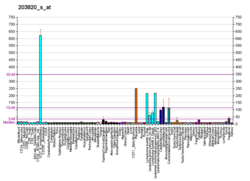IGF2BP3
Insulin-like growth factor 2 mRNA-binding protein 3 is a protein that in humans is encoded by the IGF2BP3 gene.[5][6][7]
The protein encoded by this gene is primarily found in the nucleolus, where it can bind to the 5' UTR of the insulin-like growth factor II leader 3 mRNA and may repress translation of insulin-like growth factor II during late development. The encoded protein contains several KH domains, which are important in RNA binding and are known to be involved in RNA synthesis and metabolism. A pseudogene exists on chromosome 7, and there are putative pseudogenes on other chromosomes.[7]
References
- 1 2 3 GRCh38: Ensembl release 89: ENSG00000136231 - Ensembl, May 2017
- 1 2 3 GRCm38: Ensembl release 89: ENSMUSG00000029814 - Ensembl, May 2017
- ↑ "Human PubMed Reference:".
- ↑ "Mouse PubMed Reference:".
- ↑ Nielsen J, Christiansen J, Lykke-Andersen J, Johnsen AH, Wewer UM, Nielsen FC (Feb 1999). "A family of insulin-like growth factor II mRNA-binding proteins represses translation in late development". Mol Cell Biol. 19 (2): 1262–70. PMC 116055. PMID 9891060.
- ↑ Mueller-Pillasch F, Lacher U, Wallrapp C, Micha A, Zimmerhackl F, Hameister H, Varga G, Friess H, Buchler M, Beger HG, Vila MR, Adler G, Gress TM (Jul 1997). "Cloning of a gene highly overexpressed in cancer coding for a novel KH-domain containing protein". Oncogene. 14 (22): 2729–33. doi:10.1038/sj.onc.1201110. PMID 9178771.
- 1 2 "Entrez Gene: IGF2BP3 insulin-like growth factor 2 mRNA binding protein 3".
Further reading
- Yaniv K, Yisraeli JK (2002). "The involvement of a conserved family of RNA binding proteins in embryonic development and carcinogenesis". Gene. 287 (1–2): 49–54. doi:10.1016/S0378-1119(01)00866-6. PMID 11992722.
- Yisraeli JK (2005). "VICKZ proteins: a multi-talented family of regulatory RNA-binding proteins". Biol. Cell. 97 (1): 87–96. doi:10.1042/BC20040151. PMID 15601260.
- Mueller-Pillasch F, Pohl B, Wilda M, et al. (2000). "Expression of the highly conserved RNA binding protein KOC in embryogenesis". Mech. Dev. 88 (1): 95–9. doi:10.1016/S0925-4773(99)00160-4. PMID 10525192.
- Zhang JY, Chan EK, Peng XX, et al. (2001). "Autoimmune responses to mRNA binding proteins p62 and Koc in diverse malignancies". Clin. Immunol. 100 (2): 149–56. doi:10.1006/clim.2001.5048. PMID 11465943.
- Monk D, Bentley L, Beechey C, et al. (2002). "Characterisation of the growth regulating gene IMP3, a candidate for Silver-Russell syndrome". J. Med. Genet. 39 (8): 575–81. doi:10.1136/jmg.39.8.575. PMC 1735212. PMID 12161597.
- Strausberg RL, Feingold EA, Grouse LH, et al. (2003). "Generation and initial analysis of more than 15,000 full-length human and mouse cDNA sequences". Proc. Natl. Acad. Sci. U.S.A. 99 (26): 16899–903. doi:10.1073/pnas.242603899. PMC 139241. PMID 12477932.
- Scherer SW, Cheung J, MacDonald JR, et al. (2003). "Human chromosome 7: DNA sequence and biology". Science. 300 (5620): 767–72. doi:10.1126/science.1083423. PMC 2882961. PMID 12690205.
- Nielsen J, Adolph SK, Rajpert-De Meyts E, et al. (2003). "Nuclear transit of human zipcode-binding protein IMP1". Biochem. J. 376 (Pt 2): 383–91. doi:10.1042/BJ20030943. PMC 1223771. PMID 12921532.
- Gerhard DS, Wagner L, Feingold EA, et al. (2004). "The status, quality, and expansion of the NIH full-length cDNA project: the Mammalian Gene Collection (MGC)". Genome Res. 14 (10B): 2121–7. doi:10.1101/gr.2596504. PMC 528928. PMID 15489334.
- Yantiss RK, Woda BA, Fanger GR, et al. (2005). "KOC (K homology domain containing protein overexpressed in cancer): a novel molecular marker that distinguishes between benign and malignant lesions of the pancreas". Am. J. Surg. Pathol. 29 (2): 188–95. doi:10.1097/01.pas.0000149688.98333.54. PMID 15644775.
- Liao B, Hu Y, Herrick DJ, Brewer G (2005). "The RNA-binding protein IMP-3 is a translational activator of insulin-like growth factor II leader-3 mRNA during proliferation of human K562 leukemia cells". J. Biol. Chem. 280 (18): 18517–24. doi:10.1074/jbc.M500270200. PMID 15753088.
- Hammer NA, Hansen TO, Byskov AG, et al. (2005). "Expression of IGF-II mRNA-binding proteins (IMPs) in gonads and testicular cancer". Reproduction. 130 (2): 203–12. doi:10.1530/rep.1.00664. PMID 16049158.
- Feagins LA, Susnow N, Zhang HY, et al. (2006). "Gain of allelic gene expression for IGF-II occurs frequently in Barrett's esophagus". Am. J. Physiol. Gastrointest. Liver Physiol. 290 (5): G871–5. doi:10.1152/ajpgi.00383.2005. PMID 16339295.
- Vikesaa J, Hansen TV, Jønson L, et al. (2006). "RNA-binding IMPs promote cell adhesion and invadopodia formation". EMBO J. 25 (7): 1456–68. doi:10.1038/sj.emboj.7601039. PMC 1440323. PMID 16541107.
- Jiang Z, Chu PG, Woda BA, et al. (2006). "Analysis of RNA-binding protein IMP3 to predict metastasis and prognosis of renal-cell carcinoma: a retrospective study". Lancet Oncol. 7 (7): 556–64. doi:10.1016/S1470-2045(06)70732-X. PMID 16814207.
- Li C, Rock KL, Woda BA, et al. (2007). "IMP3 is a novel biomarker for adenocarcinoma in situ of the uterine cervix: an immunohistochemical study in comparison with p16(INK4a) expression". Mod. Pathol. 20 (2): 242–7. doi:10.1038/modpathol.3800735. PMID 17192788.
This article is issued from
Wikipedia.
The text is licensed under Creative Commons - Attribution - Sharealike.
Additional terms may apply for the media files.








